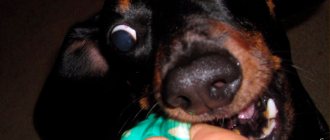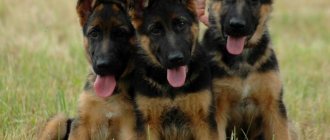The pregnancy of a German Shepherd is almost always a welcome, planned event. To get a strong offspring and maintain the health of the bitch, she is provided with proper care. It is important to know how long a pregnant dog walks: the German Shepherd is a multiparous breed, and many owners even try to take time off to be present at the birth and then help take care of the newborns.
How long does a German Shepherd's pregnancy last?
Gestational age cannot be predicted with accuracy, since gestation time varies from one bitch to another, and even within the same dog varies depending on the number of fetuses.
On average, pregnancy in shepherd dogs lasts 60-65 days.
Reveal patterns:
- the first pregnancy lasts longer than subsequent ones;
- the more fetuses in the uterus, the faster labor occurs (58-60 days).
The last week is very important for the formation of fetuses; puppies born before the 53rd day of pregnancy are not viable. On the other hand, a prolonged pregnancy is also a cause for concern: if the dog is nursing (more than 70 days), a caesarean section may be required.
Owners need to carefully record how many days after mating the dog gives birth. This will help avoid medical intervention in situations where it is not required. If your pet is continuously whelping at 70 days and the litter is healthy, the veterinarian should not suggest a cesarean section at 65 days.
The duration of pregnancy is often incorrectly determined by counting days from the date of mating. It does not always coincide with the date of fertilization. The gap between these events is sometimes 1-6 days (in the female genital tract, sperm retain the ability to fertilize for a week). Experienced breeders try to breed during the period of ovulation.
How is childbirth?
The first stage of the labor process is contractions, which can last from several hours to a day. When the cervix opens, the bitch begins to push. With frequent pushing, the fetus moves out through the birth canal.
Then the process of the puppies exiting begins - pelvis or head first. The mother must rupture the amniotic sac, gnaw the umbilical cord and lick the baby to stimulate breathing and circulation.
The bitch eats the afterbirth that came out after the puppy. It contains many substances that are beneficial for dogs. But eating more than two afterbirths is harmful , you need to watch this. Otherwise, the shepherd may have indigestion.
IMPORTANT : The birth of the first child may be delayed, but the process cannot be stimulated. Everything should happen naturally.
The birth of German Shepherd puppies occurs at different time intervals - from several minutes to an hour and a half. The birth process itself can take up to 12 hours, depending on the number of puppies.
If 2 hours or more pass after the birth of the last newborn, the mother is no longer pushing, behaves calmly and is busy with the offspring, the birth process is complete. But it wouldn’t hurt to have a veterinarian examine you to be sure that everything is fine with your pet. The doctor will inject the dog with oxytocin to help the uterus contract better.
Photo of a pregnant German Shepherd in the last week:
At what age does a shepherd dog give birth?
German Shepherds, like all large breed dogs, are distinguished by a late onset of maturity. They continue to grow and develop until they are 15 months old, and early pregnancy in a shepherd will harm both the mother and the fetuses.
The first mating is usually carried out in the third heat, at the age of 1.5-2 years. Up to 4-6 years, bitches retain high reproductive abilities.
But we should not forget that pregnancy and childbirth are a serious burden on the body of a German Shepherd. Good breeders do not breed dogs every time they are in heat, but only once a year, so that internal reserves can be restored. And even under such conditions, the body works “for wear and tear”, so bitches over 8 years old should not be forced to whelp.
In one litter, 6-7 puppies are usually born, but fertile females have 10-12, and even 15 puppies. Firstborns rarely have multiple litters.
At the age of 6-8 years, the German Shepherd gives birth to 1-3 puppies
Signs of pregnancy in a German Shepherd
If pregnancy proceeds normally, it is almost impossible to notice any external manifestations in the first month. Embryos are attached to the wall of the uterus only at the end of 2 weeks, and they are still very small.
At the age of 3 weeks, the placenta (“baby place”) is formed, but the embryo itself does not exceed 0.5 cm in size at 21 days. By the end of 4 weeks (28-30 days), the skull begins to form, and the embryo grows to 2 cm.
From day 32 the second half of pregnancy begins. Embryos are already called fetuses, and weigh about 20% of the weight of a newborn puppy (length approximately 2.7-3 cm). From day 34 (week 5), the dog’s belly begins to enlarge and its appetite increases.
At the 6th week, future puppies have already formed internal organs, eyes, bones of the spine and fingers. By day 40, the size of the fetus is about 6.5 cm. The uterus occupies almost the entire abdominal cavity, pushing aside the intestines and bladder.
From the 7th week, the bitch becomes noticeably rounder, and you can begin to prepare a “den” for giving birth and feeding puppies. On the 45th day of pregnancy, each fetus already reaches a size of 9-10 cm, and a large volume is occupied by amniotic fluid in the amniotic bladder. By day 50, babies grow to 12 cm and weigh 75% of their birth weight.
At week 8, the expectant mother tends to rest more; a large belly is not conducive to activity. Puppies that have grown to 15 cm begin to develop teeth. Starting from day 58, you need to be ready to give birth at any time. By day 60, the babies are already covered with fur and ready to be born. Depending on the number of pups in the litter, genetics and pregnancy conditions, the weight of newborn puppies is 350-500 g (18-22 cm in length).
1-1.5 days before giving birth, the bitch’s behavior changes under the influence of hormones: she hides in a secluded place, digs, and tries to set up a den. Young animals are excited and try in every possible way to attract the attention of their owners. The folds on the genital loop (edema) disappear, and transparent mucous discharge appears.
By the end of pregnancy, it is necessary to equip a maternity unit and transfer the pregnant bitch there
It is advisable to measure your temperature daily, preferably twice a day. A decrease in body temperature in puppy dogs is the most reliable sign of impending birth. Before birth (18-24 hours) it decreases by 1-1.5 C, and is 36.3-37.1 C.
Pregnancy in dogs - weekly calendar
A pregnant bitch should not be overfed under any circumstances; her rump and ribs should still be palpable, with a general increase in weight and abdominal size. The most important thing is that during a normal pregnancy, the belly should increase gradually, evenly and in proportion to the size of the dog. Towards the end of pregnancy, the mammary glands swell significantly, increase in size, and the nipples also enlarge and become clearly defined. Colostrum can come 5 days before birth, during labor or immediately after it, sometimes in the next 3 days. The latter is an undesirable phenomenon that indicates a hormonal imbalance.
In the classic version, with light pressure on the nipple 1-2 days before birth, the release of colostrum (thick, whitish-yellowish liquid) or its precursor - a straw-yellowish secretion is observed.
In ideal cases, during pregnancy, the bitch's loop is dry and clean, but quite often throughout pregnancy there is a mucous, transparent, odorless and colorless discharge. If the bitch’s health is good and the volume of discharge does not increase, then this is not a pregnancy disorder, but an individual feature, and there is no reason to worry. However, if the discharge from the loop is colored, liquid or thick with a yellow-green or bloody tint - this is a pathology, urgent veterinary help is needed. As for toxicosis of pregnancy, as a rule, it occurs little noticeably and should not give clinical signs, such as:
change in appetite;
refusal to eat;
vomiting - morning or after eating;
intestinal upset (diarrhea);
general lethargy. You should definitely consult a doctor who will select a diet for your dog based on the condition of its kidneys, liver, intestines, cardiovascular system, etc. Preparations for childbirth should begin in advance. Notify your veterinarian 2-3 weeks before the expected date.
10 days before giving birth, take anthelmintic measures, but you should avoid giving strong medications or vaccinations. A week in advance, prepare a place where the mother and puppies will be. It is better if it is a collapsible playpen (90 x 120 cm) or a large box, which should be raised above the floor by approximately 10 cm to avoid drafts and contact with the cold floor. One of the walls should be of such a height that the bitch can freely leave the nest, and the puppies cannot get out of it. Introduce the young bitch to the new place in advance.
The place where the bitch will sleep and feed the puppies should be covered with clean sheets folded in several layers. Prepare a safe heating system: an infrared lamp (hang it above the nest), a heating pad (just don’t put it under the branch to avoid bleeding) or any room heating device. The temperature in the box in the first 10-12 days should be about 28 °C, then it is gradually reduced to 20 °C. Both overheating and hypothermia are equally dangerous for puppies. Prepare a second small box with a heating pad for the puppies. There they will lie until the last one is born. It is convenient to give birth on a bed covered with oilcloth and a large clean sheet. Keep a stack of diapers and a tray with essentials on hand.
You should prepare the following: - oilcloth for the giving birth bitch; - a heating pad, preferably an electric one; - a small box - for newborn puppies; - a basin for collecting dirty diapers; — medical or veterinary thermometer; - room thermometer; - tray; - scissors, tweezers, pipettes, sterilized by boiling under a lid for at least 5 minutes; - different syringes; - cotton wool; — sterile gauze wipes (2 packs); soft diapers from old bed linen (40's 40 cm; 25×25 cm); - silk threads (put in alcohol or vodka) in case you have to tie the umbilical cord; - a notebook with phone numbers of doctors and emergency veterinary care written on the first page; - a clock to determine the time of birth; — small scales; - pencil pen); - colored woolen threads (to mark puppies); From medicines: - alcohol (vodka); — 5% glucose in ampoules; — 10% syntomycin emulsion; - hydrogen peroxide; - traumeel; — brilliant green; - calcium gluconate, oxytacin, vikasol, noshpa, diphenhydramine, saline solution, dexamethasone, sulfocamphocaine, analgin, vitamin B12 - these injection drugs may be needed in case of premature birth in the absence of a doctor.
On the eve of giving birth, trim the hair on the bitch's belly, around the loop and anus. Be sure to gather long hair into curls. The main thing is that childbirth does not take you by surprise. In any case, you should not lose your head and panic. The duration of normal labor is from 3 to 24 hours. Provide your bitch with a comfortable place and don't stress her out.
Most dog trainers believe that you should not interfere with the birth process, but for some decorative breeds this advice is not suitable. Firstly, many dwarf breeds give birth difficultly and during whelping they need the presence and attention of their beloved owner. Secondly, the long mustache and beard of some breeds, such as terriers, interfere with the bitch's ability to bite the umbilical cord. So trim your nails short, wash your hands thoroughly, and get ready for labor. The first signs of labor can vary greatly between bitches. Most of them, especially first-time mothers, become very restless, rushing around the house senselessly, scratching and tearing the bedding, whining and even moaning. Some stop eating 1-2 days before giving birth, others are not averse to having a hearty dinner and a good walk, and upon returning from a walk, they immediately go to the playpen. 4-5 days before giving birth, the bitch’s uterus drops and her back sags.
Now, if you stand the dog with its tail towards you, and its head away from you, and look at its lower back from above, you get the impression that its belly sags down, and its back (spine) seems to be separated from its belly, and “hungry” pits are indicated. From above, the bitch appears to have lost weight.
In young primiparous dogs this may not be noticeable. During the last week of pregnancy, the loop increases and softens, especially noticeable in the last 48 hours. Closer to childbirth, a sharp change in the ratio of hormones in the blood provokes a decrease in body temperature to 37 ° C and below, so 2-3 days before the expected birth, start measuring the bitch temperature 2 times a day. The temperature should be measured in the morning, before active movement begins, and in the evening, before bedtime, at rest (the dog is dozing, relaxed), otherwise the temperature will always be higher during active movements or after eating. A bitch's temperature before giving birth may drop, rise again, then on some day return to normal and drop again.
Temperature measurements are very important because the gestation period of bitches on average ranges from 58 to 65 days, and data on the timing of birth given in special tables does not reflect the individual characteristics of a particular animal.
The closer to childbirth, the lower the body temperature and the more noticeable the prolapse of the abdomen. By the time she gives birth, she becomes normal again .
Body temperature of adult dogs is 37.5-38.5 °C, puppies - 38-39 °C, respiratory rate - 14-20 per minute in adults and 20-22 in puppies;
Heart rate is 60-120 beats per minute in adults and 100-130 in puppies. In embryos, it can reach 240 beats per minute, so listening to the heart of an individual fetus in tiny puppies is extremely difficult.
The lowest possible temperature in the prenatal period lasts from 12 to 24 hours. Puppies, which were previously actively moving and pushing in the stomach, become motionless.
A few hours before the onset of contractions, the vagina swells greatly, the loop becomes very soft and sticky mucus is released from it, which owners usually do not notice, especially in small breed bitches.
If thick, dark green discharge appears, sometimes with a brown tint, then urgent veterinary attention is needed (a caesarean section may be required).
Childbirth begins with a long series of involuntary, at first not very strong and irregular contractions of the uterus. Outwardly, this manifests itself in the bitch’s restless state; she begins to scratch the floor with her paws, tremble, and her breathing becomes rapid. During this period, the birth canal expands.
The intervals between contractions at the beginning of labor can be short, up to several hours.
During this period, the temperature rises. The stronger the contractions, the shorter the intervals between them and the higher the body temperature rises (within the physiological norm). The birth canal opens, and thick, mucous, cloudy discharge appears from the loop - a “plug ”. It is usually grayish-yellowish-green in color.
This condition in a bitch can last from 1 hour to 1 day.
The intervals between contractions gradually decrease, and the strength of contractions and their duration increase. During this time, the bitch is not fed and, as a rule, is not allowed to drink to avoid possible vomiting.
Before labor begins, the dog most often calms down, sometimes it seems that her contractions have stopped, but at the same time the bitch often looks back and licks the noose. The stomach is tense at this time. During strong contractions, the puppies separate from each other and the belly becomes lumpy to the touch.
Contractions become more frequent, stronger, more regular, and they are joined by pushing. At this time, the bitch can take different positions: lie on her side, sit down; some give birth standing, others often change position, resting their paws and back against the walls of the birth box. At the same time, at the moment of pushing, the bitch raises her tail.
Gradually, the water bubble with the puppy is pushed from the pelvic cavity into the vagina and then, under the influence of strong and regular contractions of the uterus and the walls of the bitch’s abdomen, the puppy is directed towards the exit.
Let us make a small digression and recall that after implantation of the embryo, fetal membranes begin to form along with it.
Moreover, each puppy, its umbilical cord and placenta are in its own membrane (with the exception of identical twins, which are extremely rare in dogs). During the period of intrauterine development, the puppy is in a closed two-layer bubble.
The outer bubble, usually called aqueous, is filled with a jelly-like liquid. It protects the fetus and umbilical cord from compression and mechanical damage. Immediately at the moment of birth, the water bubble bursts, the liquid pours out and washes the birth canal, and the baby is born in its own membrane. Sometimes he appears from the loop several times and disappears again. An emerging water bladder should not be confused with a fetal bladder and should not be ruptured. It ruptures on its own or the bitch does it, after which a puppy appears in the membranes.
So, if you see that a light-straw-colored liquid has poured out of the loop, sticky to the touch, sometimes with a small admixture of blood, but odorless, labor has begun.
After the rupture of the membranes, sometimes not immediately, the puppy is born. Intervals can reach 3 hours and here it is important to monitor how correctly the process is going. During normal labor, after the water breaks, there is an increase in pushing, an increase in their duration, and a rhythmic alternation of pushing with contractions.
If after a certain time the puppy is born, then this interval is the physiological norm for your bitch; If the puppy is not born within 3 hours, then the bitch needs medical attention and should immediately contact a veterinarian.
Childbirth proceeds normally only if the fetuses are positioned correctly in the mother's birth canal. In this case, the puppy's spine is parallel to the mother's spine. The first to appear are the head and front legs, folded under the chin, and after several strong contractions the puppy is born whole.
The puppy can move out with its pelvis and hind legs - both presentations are normal. As soon as the puppy is born, tear the membrane near his nose and wipe his face with a soft cloth, then, evenly pulling up the umbilical cord, pull out the placenta. The umbilical cord must be broken by squeezing first to allow blood to flow to the puppy. Break the umbilical cord by holding it at a distance of 1-2 cm from the puppy and at the same distance from the placenta with the index and thumb of both hands. You can only pull towards the puppy. Cut the very strong umbilical cord with sterilized scissors and tear it apart. If the umbilical cord is bleeding, tie it with silk thread.
After the puppy is born, the bitch carefully licks it, turning it over and massaging it with her tongue. Thus, it stimulates his breathing and blood circulation. As soon as breathing becomes normal, the puppy actively crawls to the nipples and begins to suck.
If necessary, vigorously rub the puppy with warm terry cloths and suck out the mucus from the nasopharynx. We advise beginners to do this with a small syringe or mouth. Other techniques can be shown to you by your veterinarian or an experienced assistant.
Weigh each puppy and carefully examine it, make sure there is no cleft lip, cleft palate, deformation of the tail or limbs, count the number of toes, check the condition of the umbilical ring. Before the next puppy is born, write down the time of birth, gender in a notebook and tie a thread around its neck with a number indicating the order of birth. Place a dry diaper under the bitch. As soon as the next contractions begin, place the newborn puppies in a box with a warm heating pad.
Make sure all traces come out. If the last placenta is delayed for several hours, be sure to contact your veterinarian.
During childbirth, the bitch loses a lot of strength, so after all the puppies are born, it is useful to give her some milk with glucose and a few drops of cognac. Different breeds of dogs give birth to different numbers of puppies - their number can vary from 1 to 20. Small breed dogs usually have fewer puppies than large ones. In the first hours after giving birth, it is impossible to tear the bitch away from the puppies, so leave her warm and alone with the children. After a while, take her out for a walk in her usual place, wash her with a weak solution of potassium permanganate.
In the first days, the bitch secretes colostrum - a secretion of the mammary glands that forms in the last days of pregnancy. Gradually, over 3-5 days, colostrum is replaced by milk. Unlike milk, colostrum contains more proteins, fats, minerals and vitamins.
Colostrum has high biological activity and is absolutely necessary for the normal development of newborns. Antibodies found in colostrum provide puppies with passive immunity. In addition, it acts as a mild laxative and stimulates intestinal motility, resulting in the release of meconium, the original feces. Be sure to check if the puppies have passed meconium and if they have diarrhea.
On the 1st day after giving birth, the bitch should be fed easily digestible semi-liquid food, preferably fermented milk. Water must be available at all times. During the period of feeding puppies (5-7 weeks), the bitch’s body needs very high-quality, high-calorie food, and the need for calories increases weekly by 25%. It is better to feed your dog with ready-made industrial puppy food, which is quite suitable for lactating bitches.
In the first week after giving birth, the bitch should not be fed meat, as it can easily provoke eclampsia, a special form of toxicosis that occurs as a result of a decrease in calcium levels in the blood. This serious and life-threatening complication for the bitch can appear both shortly before birth and within a few days after it. Eclampsia is characterized by the manifestation of causeless fear, anxiety, nervousness; in severe cases, respiratory distress and impaired coordination of movements occur.
The bitch abandons the puppies, hides in dark corners, and sometimes becomes depressed (in this case, you need to urgently consult a veterinarian). If there is no doctor nearby, give the bitch 7-8 drops of Valocordin with 2 ml of water and 2-4 ml of a liquid solution of calcium gluconate or calcium chloride with a small amount of milk. Pour this mixture into the cheek pouch using a syringe without a needle.
Then continue to give one teaspoon of liquid calcium with milk 2-3 times a day for several days. Usually the bitch starts drinking it herself. You can give an intramuscular injection of calcium gluconate solution (up to 2 ml). In a critical situation, the doctor will give intravenous injections. Be careful, excess calcium can cause tachycardia.
During the first days after giving birth, the bitch will have an elevated body temperature. In the first 24 hours, greenish discharge may be observed, changing to reddish and gradually turning into serous-hemorrhagic. The abundance of discharge varies from person to person, but if it is absent from the first days or continues for more than 3 weeks, consult a doctor.
If the postpartum period is successful, the bitch feeds and cares for the puppies herself. If the litter is large, then starting from the 21st day it is better to start feeding them, and if the mother has a lack of milk, feeding should begin much earlier. Whining of puppies means that they are hungry or unhealthy. Sick, infected puppies often scream.
An inexperienced bitch can harm the puppy, trying to hide it from prying eyes, so do not allow strangers to the bitch and do not disturb her unnecessarily. Give your dog attention, but don't interfere with the puppies' activities.
Any bitch after giving birth requires careful attention and needs rest, proper feeding, walks, daily change of bedding and hygiene.
As soon as the bitch recovers from giving birth, she can be bathed. For walks, it is better to sew or purchase a jumpsuit that covers the stomach.
Inspect your bitch's nipples every day to avoid stagnant mastitis. Its occurrence is often associated with an excess of milk or the fact that there are few puppies in the litter, and they do not have time to suck all the milk. The affected mammary glands are painful, swollen, hard and hot, with a glossy-lumpy surface. Beginning breeders forget to examine the upper glands, as they often turn out to be underdeveloped, and puppies do not take them, but milk can also stagnate in them. In such cases, for 1-2 days the bitch is reduced in the amount of food and given a light massage with camphor alcohol, and then milk is expressed from the affected mammary gland. They try to place the most active and greedy puppies near these glands. Bitches' milk can be toxic. Acute postpartum inflammation of the uterus (endometritis) also leads to the formation of toxic milk. Puppies, born absolutely healthy and strong, after several days of feeding on such milk become lethargic, cold to the touch, often scream, and weaken literally before our eyes.
Materials based on the book by Yu.V. Sergienko "Your Puppy".
In the first 3 weeks of pregnancy, the weight gain of the fetus is insignificant, so during this period you can not change the conditions of your shepherd dog.
Usually, the dog maintains the same walking and feeding regime that it had before pregnancy. The only thing that needs to be taken into account is the increased sensitivity of the fetus to various chemicals and infectious diseases.
In order for pregnancy to proceed without complications, you should exclude the dog from being with sick animals, and also not treat your shepherd with toxic agents.
If the dog was initially overweight, it is necessary to reduce the amount of cereals and baked goods in its diet. Calories are usually replenished by eating greens and protein-rich vegetables.
In the first month of pregnancy, the dog's appearance and behavior remain unchanged, however, some individuals experience an increased feeling of thirst and excessive drowsiness a few days after mating.
The dog's diet includes, as usual, 2 feedings a day (morning and evening). Among the main products that should be included in a dog's diet during this period are raw meat, boiled liver, cottage cheese, porridge cooked in milk, pureed vegetables and herbs, finely chopped and mixed with a small amount of vegetable oil. As a supplement, we can recommend boiled sea fish without bones.
Meat products with high mineral content, such as cartilage, tendons, chicken breasts, wings and heads, are just as necessary in a dog's diet as the foods listed above. It is known that at the beginning of pregnancy, a shepherd dog needs at least 35 g of calcium and up to 25 g of phosphorus per 1 kg of its weight per day.
In order to compensate for the lack of these substances in the dog’s body, it is necessary to use calcium gluconate or calcium glycerophosphate in tablets or powders. If only calcium gluconate is used, then it must be given to the dog in combination with phytin at a ratio of 1 tablet of phytin to 2 tablets of calcium gluconate.
In addition to the above medications, the shepherd dog should receive vitamins A, D1, D3, trivit or tetravit in doses prescribed by the veterinarian.
During the period from the 4th to the 6th week of pregnancy, i.e. in the second month, it is necessary to show the dog to a doctor, since already at this time he will be able to determine the number of puppies being carried.
During this period, the number of feedings increases to 3 times a day, and the daily portion must include meat, fish and cottage cheese.
Proper development of fruits is facilitated by the constant inclusion of liquid milk porridges and soups with the addition of dry raspberry leaf in the dog’s diet. Mineral feeding increases first by 1.5, and by the 6th week by 2 times.
After 6 weeks, sudden movements should be avoided and active games should be excluded. Walks can be done for a long time, but if the dog gets tired quickly, their number should be reduced.
As a mineral supplement during the period from the 31st to the 60th day of pregnancy, we can recommend bone meal in the amount of 2 tablespoons per day. It is also necessary to give the dog 5 - 6 drops of vitamin A. It is unacceptable to overfeed the shepherd, as this can lead to complications during childbirth.
After 7–8 weeks, the daily food intake is divided into 4 times. In order to prevent the development of constipation, bones and tendons should be excluded from the diet.
In the second half of pregnancy, the dog's appearance changes significantly as a result of the lowering of the groin area. Usually the shepherd loses its appetite and gets tired quickly during walks. The duration of walks should be increased only before childbirth.
It is necessary to ensure that the pregnant bitch does not swim in ponds or fight. It is better to choose a quiet place for walks and focus primarily on the well-being of your shepherd.
Starting from the 45th day, you should definitely introduce calcined cottage cheese into your dog’s diet or give it 1 tablespoon of calcium chloride with milk.
At 8–9 weeks of pregnancy, it is not recommended to feed the shepherd with meat; it is usually replaced with boiled fish at the rate of 100 g of meat per 150 g of fish.
What does a pregnant shepherd look like?
In the second half of pregnancy (from the 5th week), the signs become obvious even to novice dog breeders.
- Enlarged belly
A pregnant German Shepherd Bitch
may simply look fatter, but with a multiple pregnancy at the end of the term, the dog’s figure becomes pear-shaped: the swollen belly drops.
- The mammary glands enlarge and change color.
Enlargement of the mammary glands
The nipples may swell as early as the fifth week, and the skin on them becomes darker. By week 7, the fur falls out around them. Sometimes the bitch facilitates this process by carefully licking her belly. A few days before birth, milk appears in the glands, sometimes it spontaneously drips out of them.
Keeping and caring for a pregnant dog
Competent care and full compliance with the rules of keeping a pregnant German Shepherd ensures the normal, full development of all future offspring, and also allows you to avoid the development of problems and complications during the birth process.
Problems of early pregnancy n4
- the first two weeks – insufficient appetite. At this stage, the dog should not be forced to eat, and the food should be light and easily digestible;
- third week – the presence of toxicosis and morning vomiting. Such problems usually go away on their own. Portions should be small, and good results are obtained by introducing broths into the diet that prevent the development of dehydration;
- recent weeks - the appearance of apathy, weakness and poor appetite. At this stage, it is necessary to supplement the diet with easily digestible foods in the form of milk and cottage cheese with a low fat content.
All dogs that are carrying their first offspring must receive special dietary supplements with calcium from the very first day of pregnancy, and from the fourth to fifth week they are transferred to an enhanced diet.
This is interesting! Magnesium can only be absorbed together with calcium, and this element is vital for the full functioning of the central nervous system. However, excessive intake of magnesium and calcium has a negative impact on a dog's reproductive function.
For dogs with allergies or nutritionally problematic animals, the diet is selected in accordance with the composition, after consultation with a veterinarian or professional dog handler.
Bearing and giving birth to offspring is a very important period, but it should not negatively affect the dog’s walks and maintenance of physical fitness. Walking in the fresh air promotes solar insolation, which has a positive effect on the pet and offspring.
- you should limit the number and duration of too active games;
- it is necessary to exclude long running and jumping;
- it is important to protect a pregnant German Shepherd from blows or falls;
- lying on a cold and wet surface is prohibited;
- travel by vehicle is minimized;
- Relaxing outdoor recreation is encouraged.
In the very last weeks before giving birth, a pregnant dog must be provided with maximum peace on a bed in a calm, spacious and cozy place.
If the mating of a German Shepherd is carried out as planned, then it is best to prepare for this process in advance by performing standard deworming and getting all the necessary vaccinations. Some difficulties may arise with unplanned matings. As a rule, complex preparations are used to vaccinate pregnant bitches, which can be used during the first third of pregnancy, which lasts twenty days. It is important to remember that vaccination of weakened or sick pets is strictly prohibited, so toxicosis in a dog is a contraindication.
Experienced veterinarians strongly advise against vaccinating a pregnant shepherd dog and vaccinating only after birth, combining the procedure for the mother and two-month-old puppies. When living in areas unaffected by zoonotic diseases or in conditions of increased risk of infection, it is quite acceptable to use a high-quality imported complex vaccine for vaccination, which is administered during the first three weeks of pregnancy.
False pregnancy
If the bitch begins to produce milk 5 weeks after her heat and her behavior changes suddenly, this is most likely a hormonal imbalance and the dog is not actually pregnant. False pregnancy can occur later, 2 months after estrus.
If mating has been carried out, the cause of such a violation may be the death and resorption of the fruits for up to 4 weeks. Some bitches are genetically predisposed to this disease and can feed other people's cubs. Signs:
- the dog sets up a nest and nurses inanimate objects like puppies (soft toy, slippers), protects the den and can show aggression;
- refuses walks, hides in a secluded place, whines and worries;
- The mammary glands swell and milk is produced.
It is necessary to hide all pseudo-puppies while the dog is on a walk and contact a veterinarian. False pregnancy itself is not dangerous and often goes away without treatment, but it can cause severe mastitis.
Diagnostics
If you realize that your German Shepherd is pregnant as soon as possible, the owners should contact a veterinary clinic. Starting from 4 weeks, you can determine pregnancy using ultrasound diagnostics, and an experienced specialist can perform ultrasound as early as 21 days.
The veterinarian will establish the fact of pregnancy and assess the condition of the fetuses, but you should not demand to name the exact number of cubs: the probability of error is too high. To find out the number of puppies, an X-ray of the abdominal cavity is taken at 48-50 days.
An ultrasound is necessary if the dog’s condition suddenly worsens - vomiting or refusal to eat, depression. The examination will help ensure that the fruits are alive. In case of frozen pregnancy or fetal hypoxia, urgent medical intervention is necessary.
How to care for a pregnant shepherd
Owners should begin planning for pregnancy long before its onset. While the dog is carrying puppies, the use of any medications is highly undesirable. All chronic diseases, if any, must be treated to stable remission in advance. Necessary:
- get preventive vaccinations at least a month in advance;
- give a broad-spectrum anthelmintic a week before mating;
- in the warm season: select flea and tick medications approved for use by pregnant animals (Bravecto tablets, collars and drops based on essential oils).
After mating, the dog is considered pregnant, and although there is no need to change food or exercise in the first month, it is necessary to handle the bitch as carefully as possible.
When playing with a pregnant shepherd, you should ensure that the dog does not injure itself.
Nutrition
It is very important to feed your German Shepherd properly during pregnancy. During this period, the bitch's body weight increases by 10-25%. In addition to fruit growth, nutrients for future lactation (proteins, minerals) are deposited. In the second half of pregnancy, the diet should be 1.5-2 times higher in calories than usual.
When eating at home, it is important to follow a number of rules:
- do not allow feeding of expired, low-quality products;
- meat, offal, fish are thoroughly boiled;
- exclude bulky foods (“empty” cereals, soups);
- Do not give foods that cause bloating (brown bread, potatoes, peas).
To compose the shepherd's diet, they use lean meat, offal, cottage cheese and cereals (rice, buckwheat), boiled vegetables (pumpkin, zucchini, carrots). With this type of nutrition, vitamin and mineral supplements must be used.
If your pet is kept on commercial food, in the second half of pregnancy and during lactation they use a diet for puppies up to two months of age (Royal Canin Maxi Starter Mother&Babydog and others). It is better if the food is from the same brand that was fed previously; the transition to a new diet is carried out within a week.
From the 3rd week of pregnancy the bitch is fed three times a day, and from the 7th week - 4 times a day. Frequent meals in small portions eliminate unnecessary pressure on the uterine horns. Water is given to drink ad libitum; pregnant females usually experience increased thirst.
During pregnancy, a German Shepherd requires an increased diet
Exercise
The fact that a dog is carrying puppies is not a reason to refuse walks. In the first month, the dog can lead a normal life. Further walks should be long, but calm. The puppy bitch is not allowed to take barriers, jump, or play with other dogs. In the summer, overheating is very dangerous, so they walk in the early morning and evening, in the shade.
A high level of activity allows your dog to maintain muscle mass and not gain weight. Obesity greatly complicates labor, contractions will be weak, and oxytocin may be needed.
Timely help
Any, even the most minor, wounds received during a walk should be washed with antiseptics until complete healing. In case of purulent inflammation, antibiotics are used, and this is extremely undesirable during pregnancy.
In case of any ailment (vomiting, diarrhea, etc.), you need to see a doctor as soon as possible in order to stop the disease at its onset.
What to feed?
A pregnant dog's weight increases by 10-25%. At the same time, in addition to the fruits, nutrients are deposited for the mother herself during the lactation period. Therefore, her diet, starting from the second half of pregnancy, should be 1.5-2 times higher in calories than usual.
It is also important to follow a number of recommendations:
- Do not feed your dog expired or low-quality products.
- Cook the meat thoroughly.
- Do not give food that causes bloating - brown bread, legumes, potatoes.
The diet of a pregnant dog includes foods high in protein - lean meat, cottage cheese, as well as cereals (buckwheat, rice), boiled vegetables (carrots, pumpkin, zucchini). Be sure to add vitamin and mineral supplements.
If the pet is kept on ready-made industrial food, then from the second half of pregnancy and throughout lactation, puppy food is used for up to two months.
From the fourth week of pregnancy, the female is transferred to 3 meals a day, from the seventh - to 4 meals a day, in small portions. A week before giving birth, the dog is not given meat, replacing it with fish and cottage cheese. This is necessary to prevent eclampsia - a special form of toxicosis in the form of seizures.











